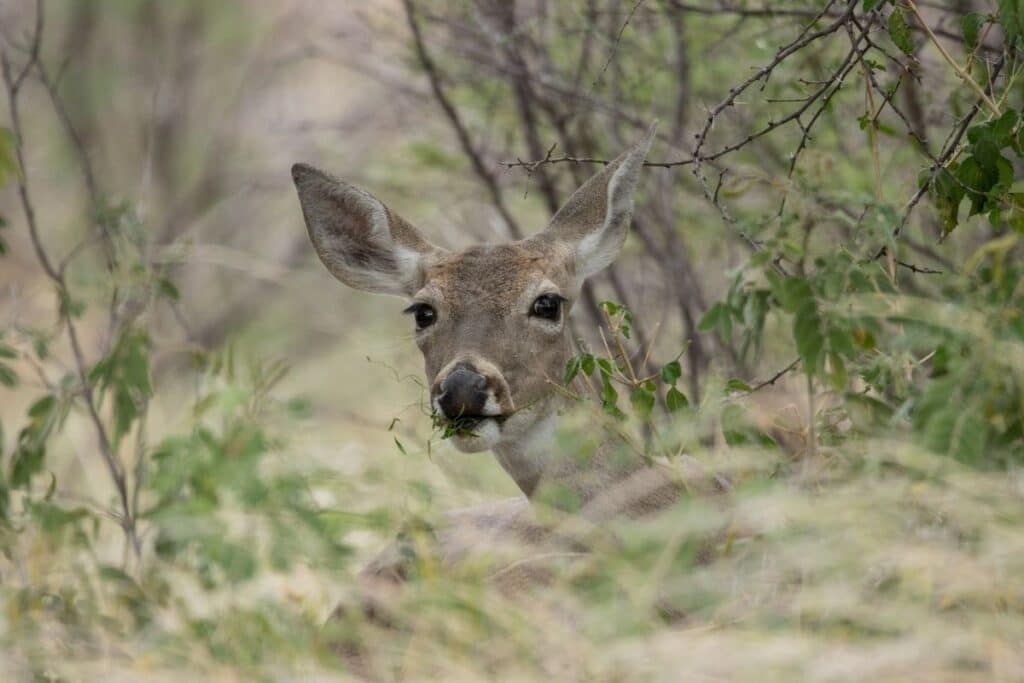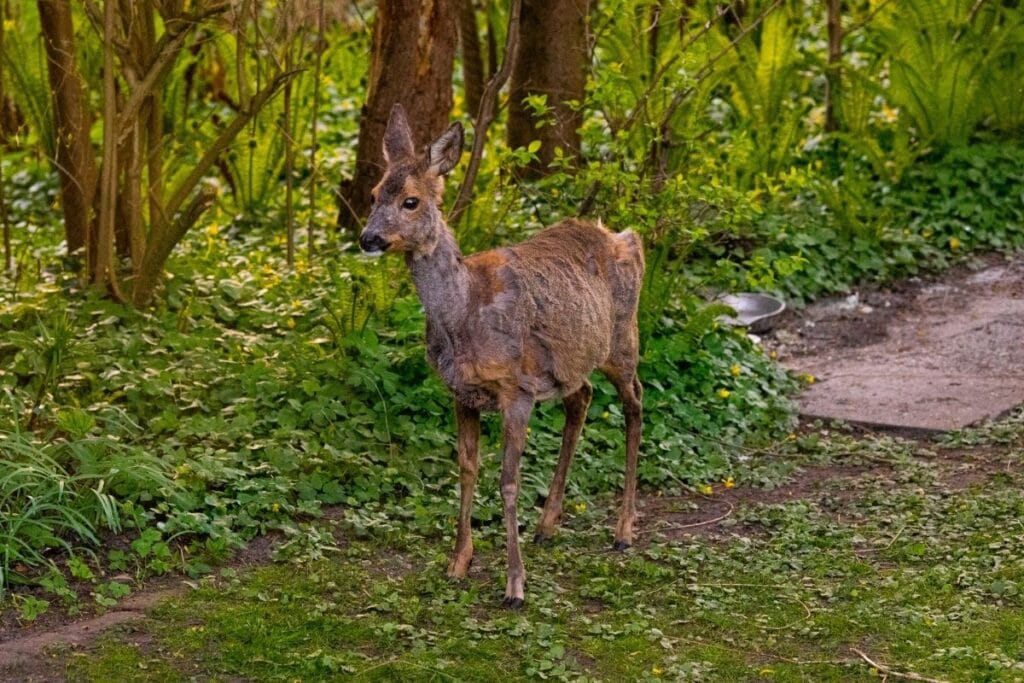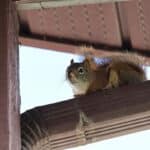Want to learn how to keep deer out of the garden? You’re in the right place.
You’ve got to admit – it’s nice having wildlife around the home. Observing rabbits, pretty birds, foxes, and deer enjoy the spaces around the house is exciting.
But only up to a certain point. Once those pesky critters begin to eat the food in the garden, then it’s time for an intervention.
If you have these animals frequenting your home, and eating the plants in the garden, keep on reading. Below you will find a host of practical strategies that we’ve compiled based on our own experience that will surely help protect your garden from deer.
What Attracts Deer to the Garden?
Deer are often curious about our yards for multiple reasons. Most often, they come exploring in search of food and aromas they enjoy.
Is there anything more beautiful than a deer eating? No – unless it’s in your garden. Unfortunately, deer problems are all too common for gardeners.
Plants that typically incentivize a deer to forage are red clover, chicory, and orchard grass.
Certain high-protein plants also attract deer in the garden because of their valuable nutritional content. When it comes to high-protein plants, deer absolutely cannot resist:
- Peas
- Soybeans
- Alfalfa
- Turnips
- Sorghum
- Kale
- Corn
Certain aromas also attract deer. There are certain delectable smells, for example, apple trees that deer love. They are also attracted to the scent of pheromones, animal urine, salt, and other minerals.

How Do You Keep the Deer Away From Your Garden?
Deer can be stubborn animals. They are very resilient. So you need to be resilient also.
The best thing you can do to keep hungry deer away from plants is to remain patient and persevere through the trials and tribulations.
In other words, protecting your garden from deer can be frustrating. It may take some time to figure out what preventative measures work best for you, your garden, and the type of deer that are frequenting your property.
When it comes to keeping deer out of your garden, you ought to focus on four key elements:
- A varieties of deer resistant plants
- Protective barriers
- Rotating repellents and sprays
- Non-violent scare tactics
Below you will find a list of 15 preventative measures that focus on at least one of the crucial elements from above. You can employ these strategies in your own garden one at a time until you find one that works. Or create a management plant that utilizes multiple strategies at once.
Here are some great tips to switch things up and help you get rid of your deer problem (and perhaps other animals, too!) for good. You can implement these tips from the front yard to the back!
1. Use Motion-Activated Lighting & Sprinklers
Deer are skittish animals. It is very easy to scare them off without hurting or traumatizing them.
These lights and sprinklers are two effective ways to prevent deer problems in your garden and incentivize them not to return.
Deer often wait until nighttime to do their feeding. By installing motion-activated flood lights near your garden, you can stop deer in their tracks. The beam of light is harmless to the deer and scares them away.
Similarly, you can position sprinklers around your yard to scare deer off. The sudden noise and moisture will scare the deer and send them running away. Over time, the deer will connect your yard with scary lights and sounds and choose to avoid it.
2. Let The Dog Out
If you are a pet owner, you already have one of the best deer repellents right inside your home. Deer are afraid of dogs because they consider them a predator. So by letting your dog out into the yard, you are effectively sending a bodyguard to protect your garden.
Now we aren’t saying to send the dogs out as attack dogs when you see deer in the yard. We are simply encouraging you to let little Fido outside more often. The more time your dog can spend in the yard, the better. The scents they leave around your yard will signal to the deer that the area is not safe for grazing.
3. Protect Plants With Fishing Line
When it comes to protective barriers, we often recommend using fishing line as the first option. The fishing line is very affordable and usually gets the job done.
When using a fishing line to protect your plants, it’s best to create a barrier that is two to three feet above the ground. Deer have a hard time comprehending what the fishing line is. As they approach the plants, the taut, seemingly non-existent barrier will confuse them and cause them to flee.
4. Try Homemade Repellents
Gardeners tend to be ‘do-it-yourselfers’. If that sounds like you, then we recommended trying out some homemade deer repellents to protect your garden. Homemade repellents are a good way to save money and to utilize things you already have around the house to create a solution.
Common DIY repellents include:
- Hanging rags soaked with fabric softeners or ammonia from trees.
- Hanging wrapped Irish Spring soap bars from trees
- Spraying homemade “deer juice” mixtures of hot pepper, garlic powder, or rotten egg.
5. Rotate Your Repellents
Repellents can be effective at protecting your garden from grazing deer. However, when it comes to using repellents, whether they are homemade or store-bought, the key is rotation. Rotating your repellents throughout the growing season will prevent the deer from adapting to the repellent.
Store-bought repellents often utilize high concentrations of capsaicin and ammonium salts to create an odor barrier. When applying repellents, it’s best to start on the ground and extend upwards to six feet.
Remember to reapply after rainfall. And to switch up your formulas from time to time.
6. Wrap New Seedlings
It’s an exciting time when the garden is full of freshly planted seedlings. So much potential!
It’s also a high-risk time because seedlings are easy pickings for deer. Nothing is worse than coming out to the garden for the morning watering and seeing a bunch of munched seedlings.
To protect your seedlings during this vulnerable time, we recommend wrapping them. You can cover seedlings with garden netting, tree protectors, or plastic tree wrap. When applied correctly, the barriers will physically dissuade the deer from eating your plants in their early stages.
7. Put Up a Fence
One of the most effective ways to keep deer away from trees and vegetable gardens is to fence it all in. The only fallback to this strategy is that it is often the most expensive and time-consuming preventive measure. However, it’s typically worth it.
There are a few options to consider as physical barriers for a deer deterrent. Electric fencing, typically solar powered, is one way to keep the deer away, but it’s not the best option (more on this below).
If you are considering putting up a fence to protect your precious plants, it’s worth considering the following conditions:
- Deer are impressive jumpers. If you want to put up a fence, make sure it’s at least 8-feet tall.
- Deer will not jump over something if they cannot see what’s on the other side. So consider a stockade-style fence instead of a split-rail fence design.
- Hooved animals do not like to walk over rocky and unsteady surfaces. If you don’t love the idea of a fence, you may consider creating a rock barrier that is at least 6 to 8-feet wide to keep deer out. Cattle guards also work well for unfenced areas like driveways.
- An electric fence might be an effective tactic, but they are not for everyone. Plus, some municipalities do not allow electric fence installation. So make sure to check your zoning ordinances before installing.
- Consider a double-layer fence. Deer hate feeling trapped. So by creating a double-layered fence design, you will incentivize the deer not to jump over the first layer.
8. Try Out Non-Violent Methods for the Best Results
Above we already talked about scaring off skittish deer with motion-activated lights and sprinklers. However, if you are not fond of those ideas, it’s okay. There are a couple of other non-violent strategies you can use to scare deer away from your yard.
Deer are afraid of new and unfamiliar objects. Keeping deer out of your vegetable garden can be as simple as installing a new garden ornament like a sundial, scarecrow, or statue. Ornaments with moving parts, like wind chimes, are even more effective at scaring away deer.
9. Create Levels
Deer can jump, but they are not good climbers. You can prevent deer from coming into the garden by adding terraces to your garden, as well as raised (or sunken) garden beds.
It might not be the most attractive option, but stacking wood pallets around your yard is often an effective strategy at deterring deer because they do not like to climb over them.
10. Keep the Garden Clean
If you keep your garden tidy, you will notice that deer stop coming around. Trim tall grasses around your property to deter deer from bedding down and hiding. Harvest your fruits and vegetables right when they are ready. Discard garden scraps into the compost pile before the deer can get to them.
11. Plant Privacy Shrubs
When deer cannot see into your garden and observe the delicious wonders that grow within, they are much less likely to invade your garden. In other words, when it comes to deer, what’s out of sight is also out of mind.
Planting robust privacy shrubs, thick hedges, edging plants, or trees around your property is an effective way to reduce deer activity and limit deer damage.
12. Use Deer-Resistant Varieties
Some plants are deer-resistant because they are toxic to deer. As young deer forage in the wild, they learn what plants to avoid from their mothers and the stomach aches they receive from eating the wrong plant.
Examples of deer proof plants that are known to be toxic to deer and plants that deer won’t eat include:
- Ferns
- False indigo
- Bleeding Hearts
- Daffodils
- Monkshood
- Poppies
If you include these plants in your garden, you will discourage deer from coming around. Remember that some plants that are toxic to deer can also be harmful to humans and pets. So we recommend doing a little research ahead of time.
13. Plant Thorny, Hairy, and Prickly Plants
Believe it or not, deer can be picky eaters. They are easily bothered by certain textures. So the next time you are deciding what to plant in your garden, try out some varieties of plants that are thorny, hairy, or prickly.
You can even position these plants in strategic areas to help protect other crops that appeal to a deer’s sense of taste. Or to protect the areas you believe the deer are entering your yard from.
14. Try Out Plants With Pungent Aromas
Natural deer repellents are effective because of their pungent aromas. If you do not like the idea of spreading deer repellent around the yard, you may consider incorporating plants with pungent aromas into your yard to attain the same effect as repellents.
If something in the area smells distasteful, most deer are much less likely to stop for a bite to eat. Examples of pungent plants that discourage feeding include:
- Thyme
- Purple Top Vervain
- Lady’s Mantle
- English Ivy
- Tuberous Begonias
- Verbena Bonariensis
- Oregano
- Lambs Ear
- Sage
- Siberian Bugloss
- Lavender
- Catmint
- Boxwood
- Rose Canes
- Bear’s Breeches
- Sea Hollies
- Globe Thistle
- Dead Nettle
- Blue Mist Shrub
Just one bite of these plants is usually enough to appeal to a deer’s acute sense of smell and taste – and get them headed off in the other direction. Deer learn quickly!
15. Keep Deer-Favorite Plants Close To Your Home
If you must plant crops that deer eat and love, it’s best to plant them as close to the home and in a small area as possible. Deer are much less likely to come around if the food they want to eat is farther away and closer to the house.
Again, you can pair these foods with plants deer don’t like around the perimeter or around the garden, bird feeder, or even the hummingbird feeder This can have the best results if you couple those plants with ones deer don’t like walking on, too.
16. Try Aluminum Foil for Deer Control
One effective method, as mentioned earlier, is using taste deterrents such as rotten eggs or moth balls. But these options may not be the most pleasant for us humans either.
Instead, try using aluminum foil to deter deer from munching on your plants. The shiny surface will confuse deer’s depth perception and they won’t be able to see the plants as clearly, making them less likely to eat them. That depth perception plays a big role in preventing deer damage!
17. Put Out Some Human Hair to Reduce Your Deer Problem
Another interesting method for reducing your deer problem is using human hair. Yes, you read that right – human hair! Scatter small piles of hair around your garden or young trees, which will give off a human scent that will deter deer from entering the area.
18. Surround Plants With Tomato Cages or Chicken Wire as an Effective Deer Barrier
If you want to take a more physical approach, you can surround your plants with tomato cages or chicken wire as an effective deer barrier. These will prevent deer from entering and munching on your plants. Another option is using t-posts and deer netting around the perimeter of your garden to create a double fence that is at least 5 feet high (or simply surrounding individual plants).
How Do You Keep Deer From Eating Your Plants?
That reality is that deer love eating our fruits and veggies just as much as we do. But the good news is that there are plenty of effective strategies to make deer eat your plants and fruit trees less often.
Regarding repellents, the most effective deer deterrents utilize intense and distasteful aromas, flavors, and textures. Sturdy and robust protective barriers and non-violent scare tactics are also effective deer deterrents. You don’t need to spend a ton of money on other products – often, the easiest way to deal with deer problems and prevent deer damage is with simple equipment like fishing wire, tomato cages, or T Posts.
Don’t forget about using plants that deer don’t like, such as bear’s breeches, bee balm, sea hollies, verbena bonariensis, lady’s mantle, lambs ear, purple top vervain, and English ivy. These are just some examples of plants that are less attractive to deer and may work great in your garden.
Finding out which strategy works best for you and your garden may require experimentation. With some patience, we are confident that these strategies for deer proofing gardens we talked about above will keep these animals away in the future.
FAQ
See more:
*image by Wirestock/depositphotos







